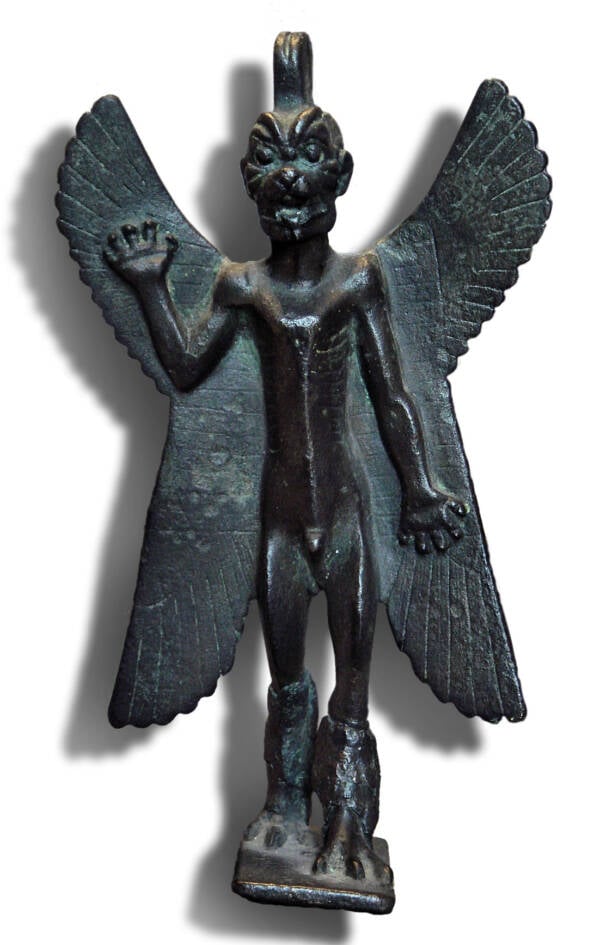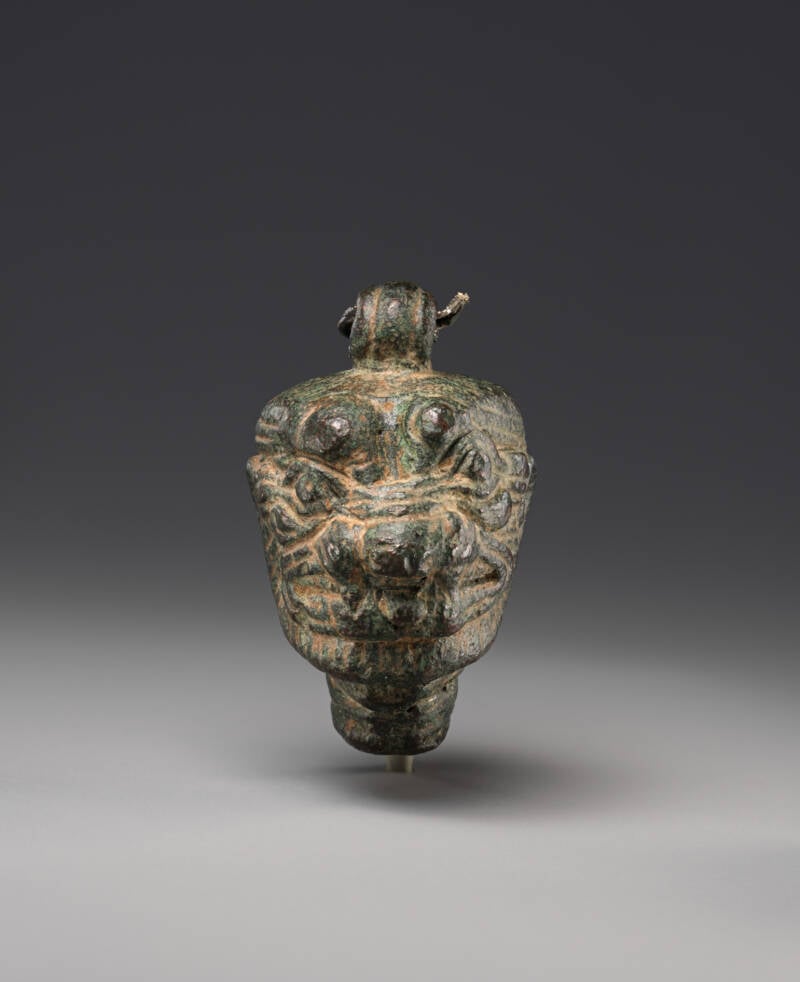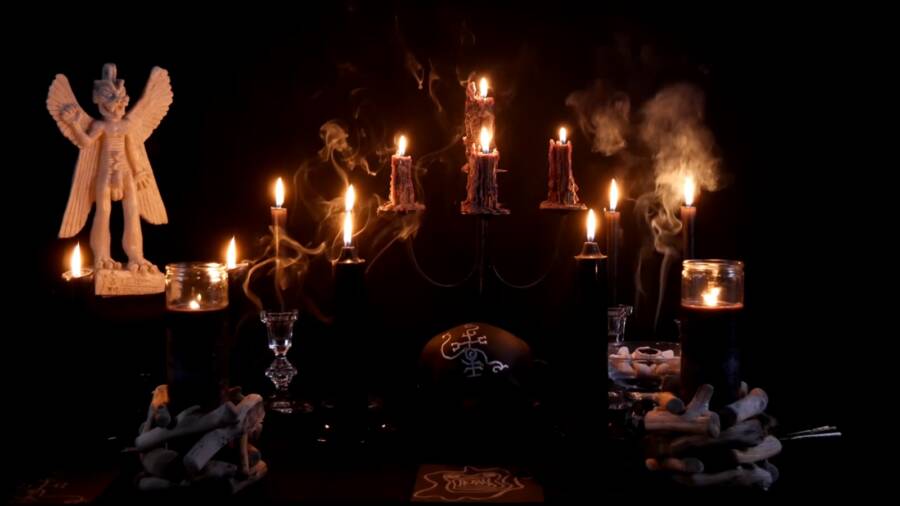Pazuzu was worshiped in Mesopotamian religion as an evil demon who controlled the wind, but also served as a protector of women and children.

Warner Bros. PicturesThe demon Pazuzu as it briefly appears in 1973’s The Exorcist.
The Exorcist is widely regarded as one of the most influential horror movies of all time. Even now, half a century after its release, it continues to terrify audiences, in large part due to its horrifying practical effects and iconic antagonist: Pazuzu.
In the film, Pazuzu is a demon who possesses the body of a young girl named Regan, transforming her from an innocent little girl into a foul-mouthed, blistered nightmare who expels green slime from her throat and twists her head a full 180 degrees. Although Pazuzu itself is only seen briefly, the few fleeting moments of its on-screen appearance leave a lingering impression.
But Pazuzu was not created for The Exorcist. In fact, Pazuzu has appeared in lore since the first millennium B.C.E., dating back to ancient Mesopotamian religion — and he was no less terrifying then than he is now.
Pazuzu In Mesopotamian Religion
In ancient Assyrian and Babylonian religion, Pazuzu was the king of wind demons, a dichotomous evil entity who simultaneously brought famine and destruction and warded off other demons. Per the Encyclopedia Britannica, the earliest archaeological evidence of Pazuzu, discovered in the grave of a royal woman near present-day Iraq, dates back to the eighth century B.C.E.

Wikimedia CommonsA bronze statuette of Pazuzu.
Images of Pazuzu are similar to those of other Mesopotamian demons, but with some distinct characteristics. Pazuzu’s head takes on a more rectangular shape and features horns, heavy eyebrows, a two-pronged beard, and an open canine-like mouth displaying his teeth and tongue.
Notably, this was the first known Mesopotamian iconography to merge multiple animal components; prior to Pazuzu, iconography typically only featured a single animal body part on a human body.
The ancient Assyrians and Babylonians regarded Pazuzu as an evil demon of the underworld who could control the wind, bringing famine during the dry seasons and storms and locusts during the rainy season. Ancient humans tried to offset Pazuzu’s destructive nature by offering prayers to him, hoping that he would contain the winds and use them for more benevolent purposes.
Pazuzu’s Dichotomous Nature
Although Pazuzu was considered to be evil, he was not evil incarnate. Pazuzu was regularly seen as a protective force as much as a destructive one, and he was invoked for protection from other demons — in particular, protecting pregnant women and children from the demoness Lamashtu, who was said to viciously murder young and unborn children.
As noted in World History Encyclopedia, the word “demon” in ancient times had a slightly different meaning from the current understanding. Following the spread of Christianity, demons are considered to be the spawn of Satan, creatures from Hell who enact their evil will over the humans of Earth as well as in Hell.
To the ancient Assyrians and Babylonians, however, demons were simply spirits. The word itself derives from the Greek word for spirit, “daimon,” and refers to lesser immortal beings that act as supernatural intermediaries between gods and humans. Demons might be sent to punish mortals, or else to encourage them to fulfill their duties.
As such, not all demons were necessarily evil, and even those who were, like Pazuzu, often had several layers of complexity to their personalities.
Depictions Of Pazuzu In Ancient Mesopotamian Art And Culture
Perhaps the most baffling thing about Pazuzu is just how difficult it is for archaeologists to determine his origin. Unlike with many other supernatural beings throughout history, there is no real trace of how the common iconography of Pazuzu evolved.
Based on the archaeological record, depictions of Pazuzu seemingly sprung up, fully realized, out of nowhere. Pazuzu’s appearance did not change over time; it was as if the world simply came to an understanding about who he was and what he looked like.
This makes it difficult for historians and scholars to pinpoint a precise location or moment in time in which these depictions took shape, though it’s likely that Pazuzu iconography originated in Egypt or Mesopotamia.

Wikimedia CommonsAn amulet of Pazuzu’s head, worn as a protective charm.
And while full-body statuettes of the demon certainly exist, it is far more common to see his likeness portrayed only as a head, usually as an amulet or an adornment on other pieces of jewelry.
In one instance, a Pazuzu statuette was found in an abandoned house, hung directly across from the entrance, leading historians to believe it had been put in place as a protection from other demons.
Amulets and other iconography of Pazuzu have been found in locations ranging from the Levant, Mesopotamia, and Iran to the Greek island of Sámos, while written sources describing Pazuzu began to appear around 670 B.C.E.
Often, these amulets and pieces of jewelry depicting Pazuzu are inscribed on the back with the images of other Mesopotamian deities, usually those considered to be allies of humans. Scholars believe this may have been done to protect the wearer and redirect Pazuzu’s power away from humans.
Why Pazuzu Withstood The Test Of Time
Pazuzu is known to us today largely due to The Exorcist, but the widespread prevalence of his iconography throughout the ancient world shows that even in his time, he was a well known and fairly popular demon. Pazuzu is also the only prominent Mesopotamian demon or deity to make its way into Hollywood films — and there may be several reasons for this.

Notably, while numerous statuettes of Pazuzu have been discovered throughout the years, no one has ever found a full-sized statue of the demon. It was believed by the Assyrians and Babylonians that depicting the likeness of a being from the underworld attracted that being’s attention.
Because of this, few likenesses of other demons, such as Ereshkigal the Queen of the Dead, were ever even made. Moreover, the size of the image also determined the amount of power it contained.
The Mesopotamians believed that the small statuettes and charms depicting Pazuzu drew small amounts of his power to protect them, as they were honoring him by wearing the protective charm, and that when invoked, he would direct that power at those who had not invoked him.

Wikimedia CommonsA Zuist altar, dedicated to Pazuzu.
Pazuzu’s status as a protector likely contributed to the widespread circulation of his iconography and, subsequently, his modern day prominence. But that still doesn’t fully explain why other Mesopotamian demons didn’t weather the course of time to the same degree.
The simplest answer is also the most obvious: Christianity.
As Christianity swept across the world, the devout no longer had a need for protective demons, and Christians naturally wanted belief in the old ways to disappear in favor of their new monotheistic religion. Demons of the old faith were relegated to Hell — after all, anything from the underworld had no place in the holy world of Heaven.
In fact, the New Testament frequently saw Jesus Christ driving demons back to Hell, and that has been echoed throughout time in various forms of media — including, of course, The Exorcist, in which a priest invokes the Bible to drive the demon Pazuzu back to Hell.
After learning about the wind demon Pazuzu, the demon that influenced The Exorcist, learn about the real-life exorcism of Roland Doe that inspired the film. Then, read the chilling story of how one of the film’s actors became a murderer in real life.





